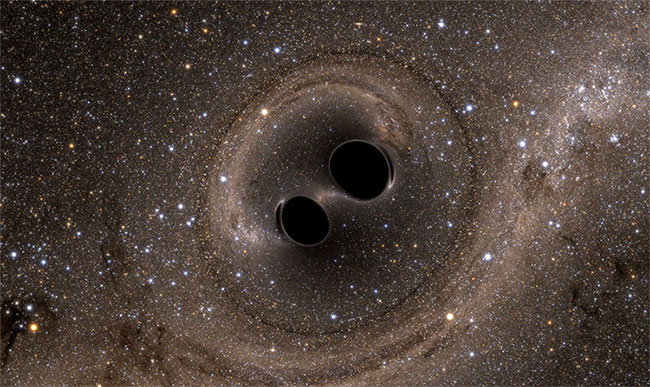The biggest black hole collision is 9 billion light-years away
Thanks to gravitational wave data, experts discovered a special event that created a supermassive black hole dozens of times more massive than the Sun.
Scientists at the Australian National University found the collision and merger between two black holes that created a new supermassive black hole 80 times the mass of the Sun , Sun reported on Dec. 5. The incident occurred 9 billion light-years from Earth and was the largest black hole collision ever recorded.
The expert team found this event from July 2017 but until now it has been verified and widely published."The speed of black hole rotation is the fastest among all mergers ever recorded. In addition, this is also the most distant merger observed , " said Professor Susan Scott, a member of the research team.

Two black holes in the integration process.(Photo: Sun).
They also discovered three other black hole collisions from August 9-23 last year, 3-6 billion light-years from Earth. The new black superhole formed from these events is 56-66 times larger than the Sun.
"Collisions occur in four different pairs of black holes, causing strong gravitational waves to radiate out into space. Finding them helps us understand more about the number of double black holes in space, mass and speed. turned black hole in a merger , " Scott explained.
Black holes in the universe are not uncommon. In fact, scientists estimate that there are about 10,000 black holes in the center of the Milky Way. When colliding, they create large gravitational wave vibrations. Sensors on Earth can capture these vibrations.
New research by a group of scientists at the Australian National University is made possible by the Laser Interferometer (LIGO) Observatory in the United States. They analyzed data collected by LIGO to find four black hole collisions.
Experts want to improve detectors to detect further events. The ultimate goal is to understand the whole history, from the time the universe began to take shape later.
Some detectors were upgraded when the second observation of the project ended in August last year."That means that in the third observation phase early next year, we will be able to detect further events, discover new things and be able to capture gravitational waves from unknown sources in the universe. " Professor Scott said.
- Video: Top 5 biggest black holes discovered by NASA in 2017
- Star 'starving' black hole is a billion light years from Earth
- Super-large black hole rotates rapidly near the speed of light
- 740 million light years away is a completely different universe of black holes
- The supermassive black hole is 20 billion times more massive than the Sun
- Discover the mystery of the most exotic black holes in the universe
- Discovering 'super black holes' is 12 times bigger than the Sun.
- Discovering a black hole 40 billion times larger than the Sun.
- The discovery of the
- Scientists have observed 1000 times the material that the Sun has just emerged from a black hole
- Detecting huge black holes revealing the universe at the age of cradle
- The galaxy's giant black hole
 Van Allen's belt and evidence that the Apollo 11 mission to the Moon was myth
Van Allen's belt and evidence that the Apollo 11 mission to the Moon was myth The levels of civilization in the universe (Kardashev scale)
The levels of civilization in the universe (Kardashev scale) Today Mars, the sun and the Earth are aligned
Today Mars, the sun and the Earth are aligned The Amazon owner announced a secret plan to build a space base for thousands of people
The Amazon owner announced a secret plan to build a space base for thousands of people